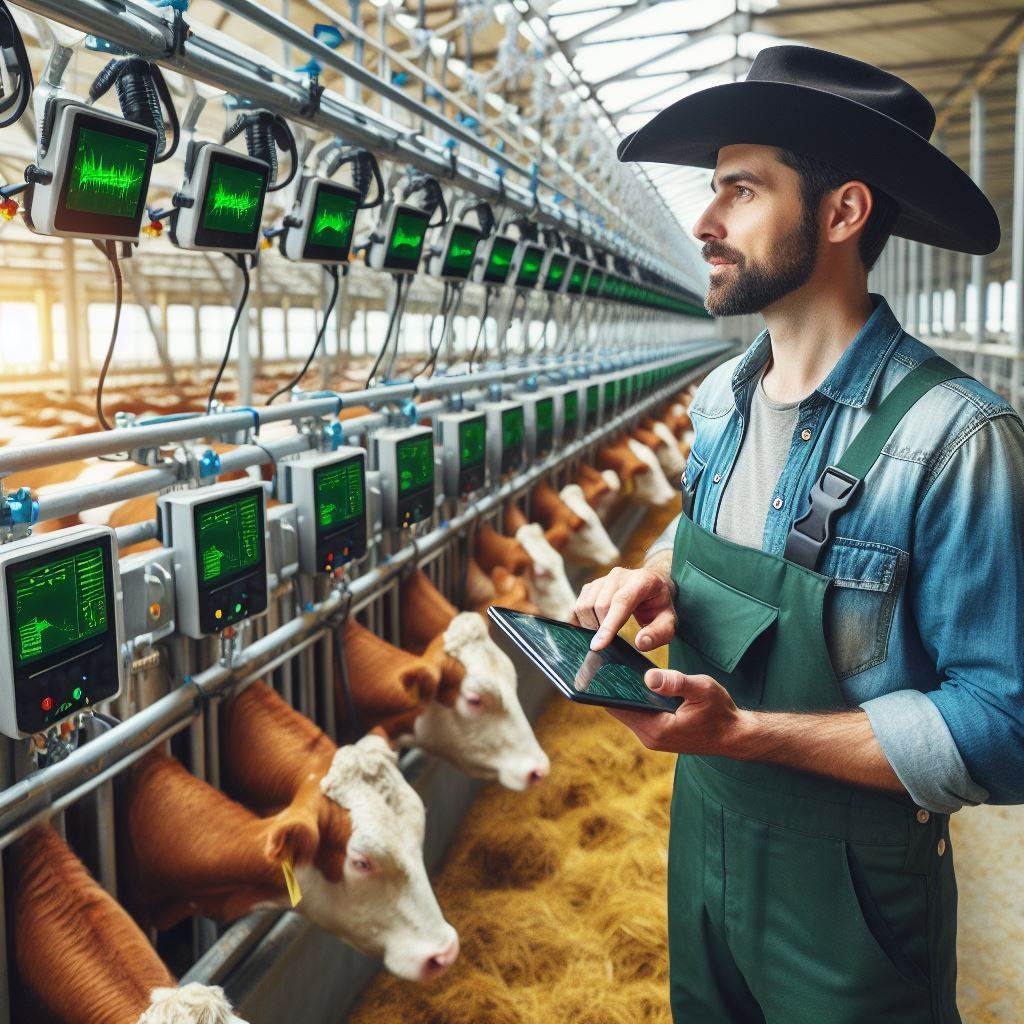Introduction
Farm data analysis
Farm data analysis plays a crucial role in optimizing farming practices and improving sustainability in agriculture.
By analyzing data collected from various sources, such as weather patterns, soil conditions, and crop yields, farmers can make informed decisions to increase productivity while reducing negative environmental impacts.
Significance of improving sustainability in agriculture
Data analysis allows farmers to identify trends, patterns, and correlations that can help them make more sustainable choices.
They can determine the optimal planting and harvesting times, adjust irrigation and fertilizer usage, and implement precision agriculture techniques.
This helps reduce water and chemical usage and minimize waste, leading to more environmentally friendly farming practices.
Moreover, data analysis enables farmers to better understand the effects of climate change and develop strategies to mitigate its impact.
By monitoring weather patterns and analyzing historical data, farmers can adapt their practices to withstand extreme weather events, such as droughts or floods.
This improves the resilience of the agricultural sector and ensures a continuous food supply.
Furthermore, analyzing farm data can also improve resource management.
By tracking resource consumption and identifying areas of inefficiency, farmers can optimize inputs and reduce waste.
This not only lowers costs but also reduces the overall environmental footprint of farming operations.
Basically, farm data analysis is essential for improving sustainability in agriculture.
It empowers farmers with valuable insights that enable them to optimize farming practices, mitigate the effects of climate change, and enhance resource management.
By embracing data-driven decision-making, the agricultural sector can become more productive, profitable, and environmentally conscious.
Understanding farm data analysis
Define farm data analysis
Farm data analysis refers to the process of collecting, organizing, and interpreting data related to agricultural practices to make informed decisions and improve farm sustainability.
Transform Your Agribusiness
Unlock your farm's potential with expert advice tailored to your needs. Get actionable steps that drive real results.
Get StartedImportance of collecting and analyzing farm data
- Enhanced productivity: By collecting and analyzing farm data, farmers can identify inefficiencies, optimize resource allocation, and increase productivity.
- Improved decision-making: Data analysis helps farmers make data-driven decisions, such as choosing the right crops, fertilizers, and irrigation practices.
- Sustainable practices: Analyzing farm data enables farmers to identify environmentally friendly practices, reducing waste and ensuring long-term sustainability.
- Economic benefits: Data analysis helps farmers identify cost-saving opportunities and improve profitability by minimizing input expenses.
- Risk mitigation: Analyzing farm data allows farmers to anticipate and mitigate risks, such as disease outbreaks or adverse weather conditions.
The types of data commonly analyzed in agriculture
- Yield data: Information on crop yield, including weight, volume, or count, helps determine crop performance and success.
- Weather data: Analyzing weather patterns, temperature, and precipitation helps farmers plan irrigation, pest control, and planting schedules.
- Soil data: Soil samples provide information on soil quality, nutrient levels, pH balance, and organic matter content, guiding fertilizer and irrigation decisions.
- Pest and disease data: Monitoring and analyzing pest and disease occurrences helps farmers implement timely control measures and prevent crop losses.
- Financial data: Analyzing financial data, including budgets, expenses, and revenues, helps farmers track profitability and make informed financial decisions.
- Machinery data: Data from farm machinery, such as fuel consumption, working hours, and maintenance records, aids in optimizing machinery usage and reducing costs.
- Market data: Analyzing market trends, consumer preferences, and prices helps farmers make informed decisions on crop selection and marketing strategies.
- Livestock data: Monitoring and analyzing data related to livestock health, growth, and reproduction assists farmers in optimizing animal management practices.
- Environmental data: Data related to water usage, greenhouse gas emissions, and wildlife conservation helps farmers adopt environmentally sustainable practices.
- Social data: Analyzing social factors, such as labor availability, community needs, and consumer demands, helps farmers align their practices with societal expectations.
Essentially, farm data analysis plays a crucial role in improving sustainability in agriculture.
By defining farm data analysis, explaining its importance, and discussing the types of data commonly analyzed, farmers can make informed decisions to enhance productivity, sustainability, and profitability.
Leveraging the power of data allows farmers to optimize resource allocation, make better decisions, and contribute to a sustainable and efficient farming future.
Read: Big Data: Transforming Agriculture
Benefits of farm data analysis for sustainability
Improved resource management
How data analysis can optimize water usage
Data analysis is a powerful tool for optimizing the usage of water on farms.
By utilizing the data collected from various sources, farmers can identify areas of water waste and implement effective water management practices.
This includes monitoring water usage patterns, detecting leaks or inefficiencies, and setting up automated systems for irrigation.
For example, by analyzing soil moisture data, farmers can determine the precise amount of water needed for each crop, thus conserving water resources and reducing unnecessary irrigation.
The role of data in efficient fertilizer application
Data analysis also plays a critical role in efficient fertilizer application.
By analyzing historical data on soil nutrient levels and crop requirements, farmers can accurately determine the right amount of fertilizer needed for optimal growth.
This not only prevents overuse of fertilizers, which can harm the environment and contaminate water sources, but also avoids under-application, which can lead to nutrient deficiencies and reduced crop yields.
Through data analysis, farmers can achieve a better balance between fertilization and crop health, resulting in improved resource management.
Enhanced crop yield and quality
How data analysis helps in identifying yield-limiting factors
Data analysis helps farmers identify factors that limit crop yield and quality.
By analyzing data on soil composition, climate conditions, and crop performance, farmers can identify nutrient deficiencies, pest infestations, or other challenges that affect crop productivity.
With this information, farmers can take proactive measures to address these issues, such as adjusting nutrient application, implementing pest control measures, or making changes to cultivation practices.
By addressing these yield-limiting factors, farmers can maximize crop yield and improve the overall quality of their produce.
The impact of data analysis on minimizing crop loss and diseases
Furthermore, data analysis can minimize crop loss and diseases.
By monitoring and analyzing data on plant growth, weather conditions, and disease prevalence, farmers can take preventive measures to mitigate crop loss.
For example, data analysis can help farmers identify early signs of diseases or pests, enabling them to intervene before the problem spreads.
This proactive approach reduces the need for excessive chemical treatments and improves the overall health of the crop, leading to higher yield and quality.
Environmental impact reduction
How data analysis aids in reducing greenhouse gas emissions
Data analysis aids in reducing the environmental impact of farming practices.
By analyzing farm data, farmers can optimize their operations to minimize greenhouse gas emissions.
This includes monitoring fuel usage, optimizing machinery routes, and adopting precision agriculture techniques.
For example, by analyzing data on machine performance and field conditions, farmers can optimize their equipment usage, reducing unnecessary fuel consumption and emissions.
Showcase Your Farming Business
Publish your professional farming services profile on our blog for a one-time fee of $200 and reach a dedicated audience of farmers and agribusiness owners.
Publish Your ProfileAdditionally, data analysis allows farmers to identify areas where energy can be conserved, such as implementing renewable energy sources or improving energy efficiency in irrigation systems.
The role of data analysis in minimizing chemical usage
Data analysis also plays a crucial role in minimizing chemical usage.
By analyzing data on pest populations, disease prevalence, and weather conditions, farmers can make precise recommendations for pesticide and herbicide application.
This targeted approach ensures that chemicals are used sparingly, reducing the risk of pollution and negative impacts on wildlife and ecosystems.
Furthermore, data analysis can help farmers explore alternative methods of pest and disease control, such as biological control or integrated pest management, which further reduce reliance on chemical inputs.
In general, farm data analysis offers numerous benefits for sustainability.
It improves resource management by optimizing water usage and facilitating efficient fertilizer application.
It enhances crop yield and quality by identifying yield-limiting factors and minimizing crop loss and diseases.
Additionally, data analysis aids in reducing the environmental impact by reducing greenhouse gas emissions and minimizing chemical usage.
By harnessing the power of data, farmers can make informed decisions that promote long-term sustainability in agriculture.
Read: Data-Driven Farming: A Closer Look
Challenges and Considerations
Data Collection and Integration
Collecting farm data can pose significant challenges that agriculture professionals and researchers need to overcome.
The process involves gathering information from various sources, including crop sensors, weather stations, and livestock tracking systems.
These diverse data sources may have different formats, units, and protocols, making it difficult to integrate them seamlessly.
Farmers and data analysts must invest time and effort in developing standardized data collection methods and ensuring interoperability among different platforms.
Moreover, collecting farm data requires overcoming logistical challenges.
Farms encompass vast areas, and accessing data from remote locations can be a complicated task.
Farms may lack proper connectivity, hindering the real-time collection of data.
Additionally, manual data collection techniques can be time-consuming and prone to errors.
Therefore, adopting automated data collection methods, such as using IoT devices and drones, can significantly streamline the process and yield accurate and up-to-date data.
Integrating data from different sources is paramount to obtain a comprehensive understanding of agricultural systems.
By combining data on soil composition, weather patterns, crop conditions, and livestock health, farmers and researchers can gain valuable insights.
For instance, integrating weather data with crop yield information can help identify the impact of climate on agricultural productivity.
However, integrating diverse datasets poses challenges due to inconsistencies in data formats, quality, and granularity.
Standardizing data and developing robust integration frameworks are crucial for effective analysis and decision-making.
Data Privacy and Security
As farm data becomes increasingly digitalized and interconnected, concerns regarding data privacy arise.
Farmers have legitimate worries about the ownership and control of their data.
They fear that sharing their data with external entities may compromise their competitiveness or expose them to data theft.
Therefore, it is imperative to establish transparent data privacy policies and frameworks that safeguard farmers’ rights and provide them with control over their data.
Data security and confidentiality are also critical considerations in farm data analysis.
The vast amount of data generated, ranging from sensitive financial information to production records, requires stringent security measures.
Implementing robust encryption techniques, secure data storage, and access controls can protect against unauthorized access and minimize the risk of data breaches.
Regular audits and compliance checks should be conducted to ensure data security practices are up to date.
Technical Expertise and Infrastructure
Effectively analyzing farm data necessitates technical expertise.
Data analysts need to possess a deep understanding of statistical modeling, machine learning, and data visualization techniques.
They must also be familiar with agricultural practices to interpret data accurately and provide meaningful insights.
Investing in developing technical skills among agricultural professionals and providing training programs can enhance the quality and impact of farm data analysis.
In addition to expertise, a robust technological infrastructure is vital for successful farm data analysis.
Farms must have access to high-speed internet connections, reliable servers, and data storage facilities.
This infrastructure enables real-time data collection, analysis, and communication.
Showcase Your Farming Business
Publish your professional farming services profile on our blog for a one-time fee of $200 and reach a dedicated audience of farmers and agribusiness owners.
Publish Your ProfileFurthermore, leveraging cloud computing and edge computing technologies can provide scalable and cost-effective solutions to handle large volumes of data.
Investing in infrastructure development ensures that farm data analysis is efficient, accurate, and accessible to all stakeholders.
In essence, farm data analysis offers significant opportunities for improving sustainability in agriculture.
However, several challenges must be addressed.
Collecting farm data poses challenges related to data diversity and logistical complexities.
Data privacy and security concerns need to be addressed through transparent policies and robust security measures.
Technical expertise and infrastructure development are essential to effectively analyze farm data and extract valuable insights.
By proactively addressing these challenges, the agriculture sector can benefit from sustainable practices and increased productivity.
Read: Big Data’s Role in Future Farming

Successful case studies
Successful examples of using farm data analysis for sustainability improvement
- Case Study 1- Smith Farms: Smith Farms implemented farm data analysis techniques to track water usage and optimize irrigation methods. This resulted in a 30% reduction in water consumption.
- Case Study 2 – Green Acres Organic Farm: Green Acres Organic Farm utilized farm data analysis to monitor soil health and nutrient levels. As a result, they were able to refine their fertilization practices, leading to increased crop yields.
- Case Study 3 – Johnson Ranch: Johnson Ranch incorporated farm data analysis into their pest management strategies. By analyzing pest populations and weather patterns, they implemented targeted interventions and reduced pesticide use by 50%.
Outcomes and impacts of these case studies
- Increased Efficiency: The successful implementation of farm data analysis techniques allowed these farms to optimize their operations and improve resource efficiency. This resulted in reduced water consumption, improved soil health, and decreased pesticide use.
- Financial Benefits: By utilizing data analysis, these farms were able to make informed decisions about resource allocation, leading to cost savings. For example, the reduced use of water and pesticides resulted in lower input costs.
- Environmental Sustainability: Through the adoption of data-driven practices, these farms made significant strides in enhancing sustainability. By conserving water, improving soil health, and reducing chemical inputs, they minimized their environmental footprint.
- Improved Crop Quality: By analyzing farm data, these farms were able to optimize crop management practices, resulting in improved quality and yield. This led to increased customer satisfaction and market demand for their products.
- Knowledge Sharing: Successful case studies encourage knowledge sharing among farmers and the wider agricultural community. As more farms adopt data analysis techniques, the industry as a whole benefits from improved sustainability and efficiency.
These case studies highlight the tangible benefits of farm data analysis in promoting sustainability.
By harnessing the power of data, farmers can make informed decisions, optimize resource usage, and contribute to a more sustainable and resilient agricultural sector.
Read: Data Analytics in Modern Farming
Implementing farm data analysis for sustainability
Steps and guidelines for farmers to start analyzing farm data
- Identify the objectives and goals you want to achieve through data analysis.
- Collect and organize relevant farm data, including production records, soil samples, and weather data.
- Choose a data analysis method that suits your needs, such as statistical analysis or machine learning algorithms.
- Clean and prepare the data by removing outliers, filling in missing values, and ensuring data accuracy.
- Utilize software tools or hire data analysts to analyze the data and extract useful insights.
- Interpret the results and identify patterns, trends, and correlations in the data.
- Use the insights gained to make informed decisions and implement changes on the farm.
- Monitor and track the impact of the changes made, comparing them to the initial goals set.
Tools, software, and technologies available for data analysis
- Farm management software: These tools help farmers track and manage farm data, including production records, inventories, and financials.
- IoT devices: Sensors and devices connected to the internet collect real-time data on soil moisture, temperature, and other environmental factors.
- Geographic Information Systems (GIS): GIS software allows farmers to analyze spatial data, such as soil maps or satellite imagery, to make more informed decisions.
- Machine learning algorithms: These algorithms can analyze large datasets and identify patterns, making predictions and optimizing farm operations.
- Cloud computing: Storing farm data in the cloud enables easy access, collaboration, and scalability, without the need for extensive on-site infrastructure.
- Data visualization tools: These tools help interpret complex data by presenting it in a visually appealing and understandable format, facilitating decision-making.
The importance of continuous monitoring and evaluation of data analysis efforts
- Ensure data accuracy: Regularly monitoring and evaluating data analysis efforts helps identify any errors or inconsistencies in the data, ensuring accurate results.
- Adapt to changing conditions: By continuously monitoring data analysis efforts, farmers can identify changing trends or patterns and make necessary adjustments to their strategies.
- Improve decision-making: Evaluating data analysis efforts allows farmers to assess the effectiveness of their decisions and make necessary improvements for better outcomes.
- Optimize resource allocation: Regular monitoring and evaluation help farmers analyze resource utilization and identify areas where optimization can be achieved, improving sustainability.
- Enhance long-term planning: Continuously analyzing data allows farmers to make more informed decisions for the future, considering long-term sustainability and profitability.
- Stay ahead of competition: Continuous monitoring and evaluation of data analysis efforts enable farmers to stay updated and adopt new technologies or techniques ahead of competitors.
In a nutshell, implementing farm data analysis for sustainability requires farmers to follow specific steps and guidelines, utilize appropriate tools and technologies, and prioritize continuous monitoring and evaluation.
By embracing data-driven insights, farmers can make informed decisions, optimize farm operations, and contribute to a more sustainable agricultural industry.
Explore Further: Tech in Poultry: Innovations Unveiled
Conclusion
Importance of farm data analysis for improving sustainability
Throughout this blog, we explored how advanced data analysis and modeling can transform farm operations to be more efficient, productive, and sustainable.
By harnessing the power of data, farms can reduce waste, optimize resource utilization, and maximize yields while minimizing environmental impact.
Data-driven insights enable evidence-based decision making to improve economic and environmental sustainability.
Encourage farmers to embrace data analysis as a crucial tool for sustainability in agriculture
While transitioning to data-driven agriculture requires investment in skills and technology, the long-term benefits for farmers and the planet are immense.
Data analytics takes the guesswork out of complex farm management decisions.
The future of sustainable agriculture relies on farmers embracing data modeling and analysis as a core tool.
Technology is evolving rapidly to make precision agriculture more accessible and customized for farms of all sizes.
By proactively exploring modern data analysis solutions for their unique needs, farmers can future-proof their operations while reducing their carbon footprint.
The time has come for data-driven farming to take center stage in revolutionizing agriculture worldwide.
The opportunities start by simply taking the first step – start tracking, start measuring, start analyzing.
Data can guide the way to a more sustainable future.




